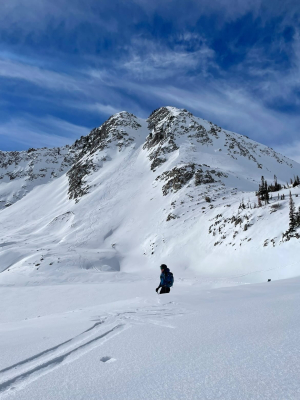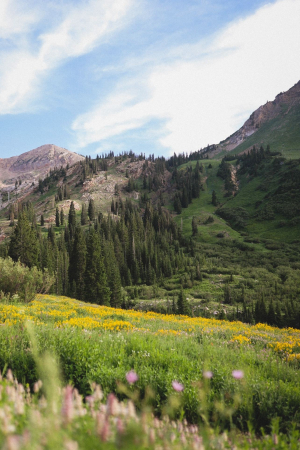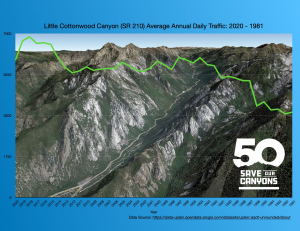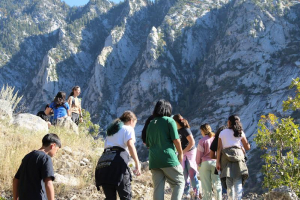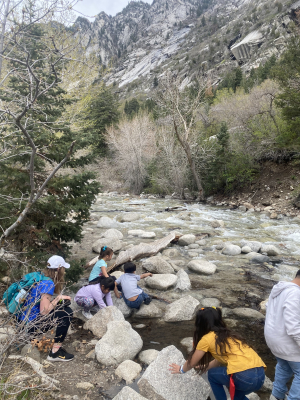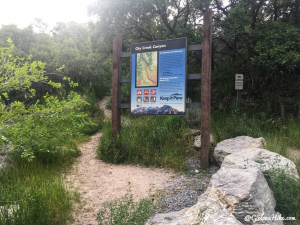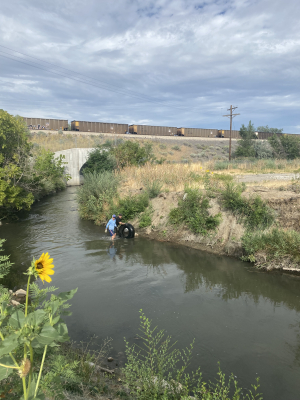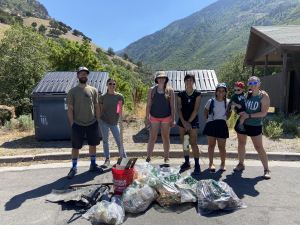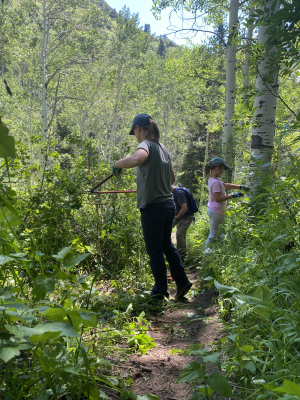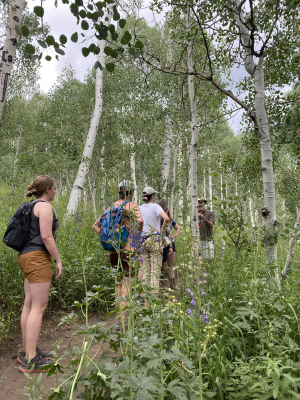Claire Parsons
Central Wasatch Resort Employee Survey
Save Our Canyons wants to hear from you, the resort employee up Big or Little Cottonwood Canyon, that makes winter seasons possible year after year.
We are continuing to see a dramatic increase in traffic and attendance at the ski resorts that reside in Big and Little Cottonwood Canyon. We are all exhausted by the lack of efficient transportation solutions across the valley, the hours and hours of idling in the canyon waiting to make it to the resort, and how this issue is steadily changing the identity of the Wasatch to be negative.
It is time to set a stage for the resort employees to discuss:
-
- Their identity in these canyons.
- How they commute to work - what works and what does not.
- Issues they have been facing.
- Provide any suggestions that would make this entire system run more efficiently.
As we are facing the possible development of a massive gondola system that will change Little Cottonwood Canyon forever - we want to provide a space for you to share your input, concerns, and ideas about how we can better advocate for you and transportation solutions.
Please share this survey far and wide! Share the Google Form Link and/or the QR Code found below. We are striving to get a large amount of submissions from resort employees across both canyons.
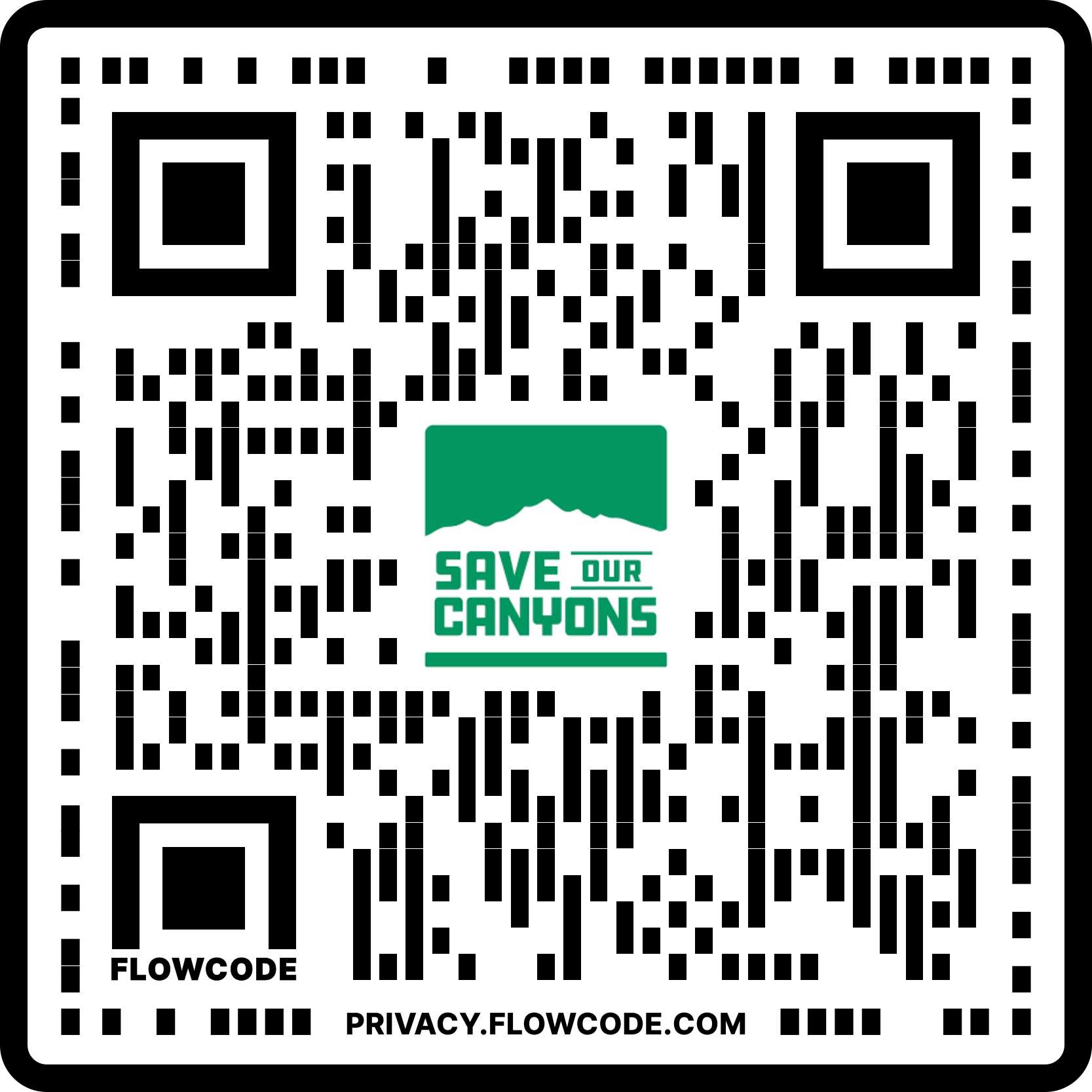
Thank you for taking the time to take this survey! We will share your responses towards the end of the 2023 Winter Season.
***Please note all responses will be shared anonymously unless you specify otherwise.
Tri-Canyons Master Plan
What are the Tri-Canyons and what is The Tri-Canyons Master Plan?
Over the last ten years, the Wasatch Mountains have been experiencing a continued increase in recreation and visitation. Visitation in this area, driven primarily by population growth in the region, is staggering. Visits to the Uinta-Wasatch-Cache National Forest Tri-Canyons area exceeds that of many of the National Parks in the state. It is imperative to formalize a long-term management plan for these mountains.
The most frequented canyons across the Wasatch are the “Tri-Canyons”. The Tri-Canyon area includes Millcreek Canyon, Big Cottonwood Canyon, and Little Cottonwood Canyon (see image below). These canyons are made up of both public and private lands. The US Forest Service Salt Lake Ranger District (SLRD) is responsible for the National Forest and Wilderness Area boundaries across the Tri-Canyons and are eager to put forth a Tri-Canyons Master Plan that will focus on bettering the existing trail systems, protecting the watershed, and strengthening habitat conservation efforts.
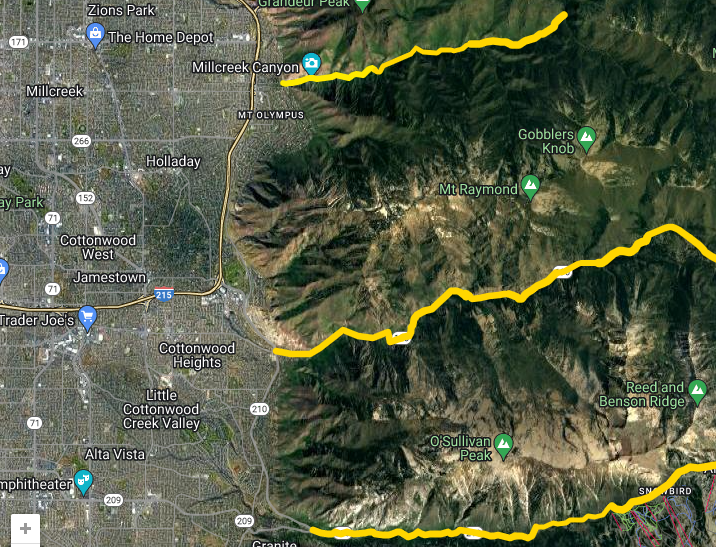
What will the Tri-Canyons Master Plan accomplish?
This master plan will act as a framework that promotes a collective vision to ensure the future of the Wasatch has conservation at its core. We have seen firsthand both the resource impacts and the demand this beloved region has incurred, all compounded by population growth and climate change, underscoring the need for an integrated conservation and recreation plan. It is up to all of us to formalize a plan that defends resource goals, focuses on rehabilitation and rewilding, well-planned trail systems, and provides the space for the Wasatch to breathe.
The importance of this geography to our members and community is complex. First and foremost, these areas are a watershed for Salt Lake County. As more people continue to exist across the Tri-Canyons, the bigger the impact on the environment and the waterways. The master plan should be sure to focus on water and habitat conservation efforts.
Secondly, this area is home to some of the most breathtaking backcountry access in the Intermountain Region. With visitation increasing, the SLRD is continuing to collect data on user created trails that inevitably impact land, water, other users, and flora and fauna in the designated Wilderness Areas of the Central Wasatch Mountains. The goal of this trail inventory project is to better understand which trailheads and trail systems see the most use and need the most maintenance.
Who is involved in the Tri-Canyons Master Plan?
-
-
- YOU!
- Salt Lake Ranger District
- Save Our Canyons and many other local nonprofits and coalition groups
- National Park Service
- Landmark Design
- Central Wasatch Commission
- Local government and county councils
-
With a master plan in the works that will naturally involve many different user groups and stakeholders, the SLRD has applied to work with the National Parks Service. Balancing conservation priorities with recreational demand has been a challenge that the National Park Service has risen to. Although the Wasatch is not a National Park, it is true that we experience the same volume and usage as the surrounding National Parks across the state - in turn, the Wasatch needs the same level of attention, funding, maintenance, and proactive management. We believe the expertise and experience the National Parks Service can lend to this project can aid in balancing competing priorities for the benefit of the many values intrinsic to the land, the water we are reliant upon, and the opportunities we seek to share with other people.
This is a scaled effort that Save Our Canyons has consistently worked with the Forest Service on for many years and we need our members to be actively involved so that we create an effective management plan. With 1,800 native plant and animal species in the Wasatch and millions of annual visitors, we take our responsibility of caring for these areas seriously and fully support the development of a Tri-Canyon Master Plan in hopes that it will help us improve our watershed, ecosystem health, and the future of recreation opportunities and promote a legacy of stewardship we can all be proud and part of.
Take a moment to read through the Mountain Accord that was established in 2015 to better understand the conservation history of the Wasatch and who has been at the forefront of protecting this environment.
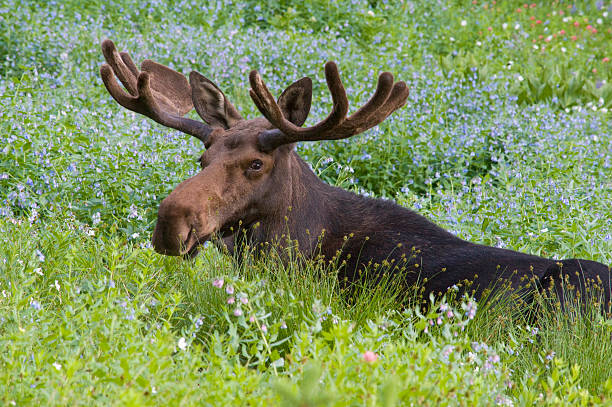
Next Steps and How You Can Get Involved
The Salt Lake Ranger District will be hosting three public listening sessions (details below) for the community to join together to learn more about the project, voice their ideas about the trails and the canyons, suggestions for their management plan, and ask the Forest Service questions about the Tri-Canyons Master Plan. We encourage you to attend any or all of these listening sessions! The Salt Lake Ranger District needs to hear from the community that cares, enjoys, and wants to protect the Wasatch Mountains.
After the listening sessions, the Salt Lake Ranger District will take the information they gathered from the community and begin to write the first draft of the Tri-Canyons Master Plan which will be released Summer 2023. Attend the virtual meetings here on Webex!

Additional Resources:
1. You can learn more about the SLRD Tri-Canyons Master Plan timeline here: https://www.tricanyontrails.org
2. Central Wasatch Trail Use Report - February 2023.
3. Read our blog post: An Increase In Visitation Pressure Across The Central Wasatch Is Undeniable.
4. Be sure to follow us on Instagram and Facebook to stay informed
As we are continually facing population growth in the Salt Lake City valley, it is important to remember that this is an upward trend and the Central Wasatch is feeling the pressure. Our canyons are seeing visitation levels like never before (reference graphs). The traffic issues we have seen for decades in Little Cottonwood Canyon are no longer simply isolated there. The congestion we experience year-round of idling cars, abysmal public transportation opportunities, and vehicles not following traction laws in the winter is happening in Little Cottonwood, Big Cottonwood, and Millcreek.
With the proposed gondola now selected as the Utah Department of Transportations preferred alternative to “solve” the mobility issues in Little Cottonwood Canyon - there are some very key points to keep in mind.
- The proposed gondola is estimated to improve mobility by 30%. That is it.
- Parking for the gondola does not exist yet which means more parking lots will need to be developed at the mouth of Little Cottonwood Canyon just to serve patrons.
- The gondola runs only in the winter… we experience these issues year-round.
- The gondola is fully funded by taxpayers meaning that the majority of the state that does not ski at the private ski resorts in Little Cottonwood will be required to contribute to this project.
- The gondola is STATIC. Once built, it is what it is. A gondola system cannot evolve with a growing population. Common sense solutions can. Busing, affordable tolling during peak visitation periods, establishing transportation hubs, and so on. These solutions can also scale back if visitation was to ever lessen. With a population that is destined to continue growing, how will a gondola system that only serves TWO locations - Alta and Snowbird - cater to the transportation needs of the valley?
The graphs below are great demonstrations of the sustained, increased visitation that Big Cottonwood Canyon and Little Cottonwood Canyon have experienced from 2020 to 1981. Visitation in both canyons has skyrocketed in the last 8 years which is a trend that runs parallel to the population growth in Salt Lake City. We need to create proactive, long-term transportation solutions and regulations that are a proper match to the pressures both the Central Wasatch and Wasatch Mountains face.
Fall SOCK hike in Little Cottonwood Canyon
The fall weather has been absolutely incredible these last few weeks and we could not wait to get back outside with the YMCA Eisenhower group we took out to City Creek Canyon earlier this April. On October 7th, we had the exciting opportunity to meet at the mouth of Little Cottonwood Canyon and hike the Alpenbock Loop. This was a very different experience for them than the last time we hiked together. I was eager to take them off of the foothills and get them into the heart of one of our most famous canyons.
The Alpenbock Loop runs beneath walls of granite and creates a very stimulating hiking experience. The trail is rocky, a bit overgrown, and provides periodic shade with tunnels of maple trees. This trail pushed the group to step out of their comfort zones and be very communicative with one another to ensure everyone was safe. We needed to be sure everyone had stable footing and was taking plenty of breaks as this was 5 out of the 16 students first time ever hiking in their lives.
The students were incredibly blown away by the panoramic views - to the east you see the entire Salt Lake City valley and to the west you see the heart of Little Cottonwood Canyon. They truly could not believe in just 30 minutes, they drove from school, and found themselves in this gem of nature. Many students felt proud of themselves after completing this hike and made sure I knew they really wanted to come back to explore these spaces more. Many of these students are growing into their own and mentioned that taking the time outside and away from school was hugely beneficial to their mental health. They felt grateful for a few hours to decompress and be off their devices. This is our third hike with YMCA Eisenhower! It is always an absolute joy to be able to show up for these students and share the Wasatch with them.
Hiking with students from YMCA Redwood Elementary!
Spring is the best time to get students out and into the woods. Wildflowers are starting to bloom, the air is cool, and the air quality is usually in a good place. On May 5th, we had the opportunity to bring 35 K-4th graders out into Little Cottonwood Canyon from YMCA Redwood Elementary. We spent the afternoon exploring the Temple Quarry Trail. This paved walkway runs along Little Cottonwood Creek and is a place-based learning wonderland. From a rushing creek, to American dippers flying underfoot, to a tunnel of oak trees, this area is meant for younger students.
This hike provided the perfect opportunity to paint the picture for the students of how exactly a watershed works. In this area, you are able to see the snow covered mountains that will soon melt, run down the canyon, and then be treated so we can all drink it. This is a concept that quite literally blew their minds. We made sure to sit down and really process our surroundings.
We discussed what we heard, what we felt, what we saw, and how a place like this makes you feel. Hearing from such young students was invaluable. They mentioned feeling excited, comforted, calm, and “like they could do anything”. Cultivating this sense of awareness and empowerment is exactly why we run our Save Our Canyons Kids program. Allowing students of any age and any background a front row seat to enjoying the wild spaces of the Wasatch mountains.
SOCK Hike in City Creek Canyon
On April 29th, 2022, we were able to hop out onto the Bonneville Shoreline Trail at the mouth of City Creek Canyon with 12 students from YMCA Eisenhower to explore the foothills. It was a perfectly cloudy day to get outside and discuss the value of sharing public land.
We were able to hike 0.75 miles and spend a lot of time enjoying City Creek. This was an amazing opportunity to allow the students plenty of space to decompress. They mentioned how stressful the end of the school is and that many of them had not been out on the Bonneville Shoreline before. I was very excited to expand on topics like our watershed, Wasatch ecology, and teach them more about how biodiverse the mountains just outside of the Salt Lake Valley are. Being able to hold space for these students on the trail allowed them to feel a sense of accomplishment, exploration, and peace.
Even though this is a trail with access for all, this area is definitely pushing the concept of barriers to nature. As you drive up to the trailhead, you do happen to pass through a very wealthy neighborhood and this is something multiple students referenced - expressing how “No wonder we wouldn’t come up here” or “I guess these mountains are for the rich.” It was important to understand how the students were feeling as they were engaging with nature and reassure them that we each have a space in the mountains, foothills, canyons, and so on. After a beautiful time together, we planned a hike for the fall. It will be great to take these students out to a different part of the Wasatch next time to reinforce that all areas are areas for them to enjoy.
Big Cottonwood Creek Restoration Project
It is absolutely incredible to see the positive outcome of working together with various community partners to care for our watershed. On August 13th, volunteers from Save Our Canyons, Seven Canyons Trust, and Keep Nature Wild, joined together to remove trash out of Big Cottonwood Creek and eradicate an invasive species of thistle.
Over 70 people attended this event and in just 2.5 hours, we were able to remove over 8,500 pounds of trash out of the creek - tires, duffel bags, real estate signs, pieces of industrial pipe, sport nutrition snack wrappers, and on and on and on. Hosting successful volunteer work days like this shows two things - the community is eager to restore the Wasatch Front and waterways really can pick up and carry all kinds of pollutants.
We are eager to continue working together with Seven Canyons Trust and Keep Nature Wild because we all collectively care about the future of watersheds, environments, mountains, and the surrounding communities.
Highway cleanup in Big Cottonwood Canyon with Keep Nature Wild
Many years ago, Save Our Canyons eagerly adopted mile 8-10 up Big Cottonwood Canyon (BCC) to better protect this heavily used area in the Wasatch by hosting trash cleanup volunteer days. Our section runs from the Mineral Fork Trailhead to the Butler Fork Trailhead. Even though this only covers two miles of highway, you would be shocked to see how much trash can build up on either side of the highway.
Lucky for us, we partnered with Keep Nature Wild and their amazing group of “Wild Keepers” to host a trash cleanup mid-July 2022! We met at the BCC Park & Ride bright and early on a Wednesday to beat the summer heat and to carpool up the canyon. With the help of four Wild Keepers, Bri Sullivan from Keep Nature Wild, and Alex Schmidt and Claire Parsons from Save Our Canyons - we were able to pick up over 90 POUNDS of trash in only 2.5 hours! We found many sport gel wrappers, granola bar wrappers, crushed up cans, and oddly enough, pieces of cars like bumpers and taillights.
With COVID slowing down our volunteer workdays, it was uplifting to see that even though 2+ years have passed since our last trash cleanup in BCC, the level of trash found on this day was not as bad as we had expected. It makes you feel grateful for the few trash cans that are placed and eager to get more in place. We are really excited to start our highway cleanup projects up again and look forward to hosting more this fall and next spring.
First Wilderness Stewardship Project of the year!
We were excited to kick off our 2022 Wilderness Stewardship Project on July 16th at the Butler Fork Trailhead in Big Cottonwood Canyon. Last season, we spent two different work days, over 10 hours, and covered around 8 miles of trail in this area and were thrilled to pick up where we left off.
Not only does this particular trailhead see a lot of use, but it also is a prime connector for many other trails and lakes in the canyon. With that being said, the trail is steep and runs for miles and miles. We are lucky to say we have contributed to the beautification and maintenance of about 15 miles of this trail in the last year.
On July 16th, we were determined to hike about two miles through the amazing wildflowers and aspen to an area that had become extremely overgrown. We were working on areas in the Mt. Olympus Wilderness. When trail sections become overgrown, it causes trail users to stray off the trail to avoid having brush in their faces. This causes the trail to widen over time. The reason we try to avoid trail widening is two fold: we want to create as little impact as possible on the environment and when trails lose their integrity or initial build, problems can occur - wash out, run out, and so on.
With the work of six incredible SOC volunteers and the US Forest Service staff from the Salt Lake Ranger District, we covered 3.5 miles of trail, removed brush and overgrowth, and created a better flowing trail section. There is nothing more satisfying than knowing that the work we do with the help of our volunteer community is bettering these wilderness areas for many more seasons to come. We are excited to host our next trail work day on August 20th! If you are interested, please RSVP https://saveourcanyons.org/resources/wilderness-stewardship-project or contact Claire Parsons at .
Wildflower Hike with Utah Native Plant Society
Summer is in full swing in the mountains and that means it is wildflower season! One of the most spectacular things about the Wasatch mountains is that it consists of many different plant habitats - high desert to Douglas fir forests to subalpine meadows even up into the true alpine above 9,800 feet. We are lucky to have access to these very diverse plant communities that are home to stunning blooms and happy pollinators.
Lucky for us, the Utah Native Plant Society (UNPS) is incredibly dedicated to educating the public about the value of plant communities, how essential plants are to both the mountains and animals, as well as how we are all capable of learning the hundreds of plants that grow throughout the Wasatch mountains.
On July 13th, UNPS’s very own, Marc Coles-Ritchie, was kind enough to lead members from the Save Our Canyons community on a wildflower hike starting at the Willow Lake Trailhead in Big Cottonwood Canyon. Over his decades of being an ecologist and stewarding public land, his knowledge of plants and plant ecosystems is invaluable. Our group was filled with passionate recreationists that were eager to learn more about the plants that constantly pass by as they are hiking or running in the canyons.
Our hike consisted of some iconic Utah native plants. Most notably, paintbrush, fireweed, meadow rue, Jacob’s ladder, sticky geranium, and larkspur. We were surrounded by tall aspen and miles of thick meadows filled with these blooms. Not to mention amazing cloud cover that gifted us with some rain towards the end of our hike. It was amazing to see how engaged and excited everyone was to finally understand more about the flowers we all take for granted or better yet, the ones we always photograph hoping one day we will identify them.
It was a joy to partner with UNPS and we are eager to get back out on the trail with them in the future. If you are passionate about plant conservation and would like to get more involved with the Utah Native Plant Society, please consider checking out their website, joining their email list, and making a donation!

